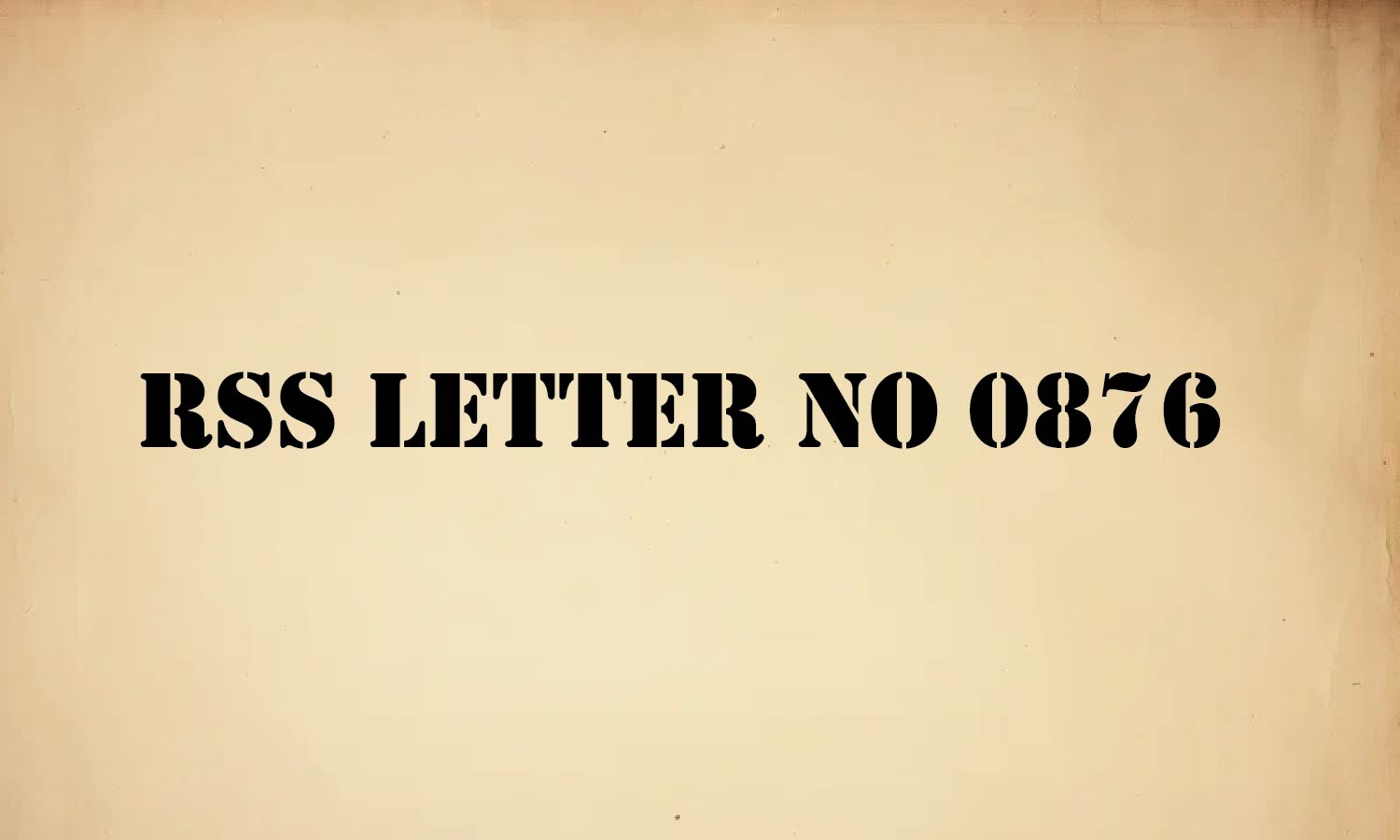News
Unlocking the Mystery: What is “RSS Letter No. 0876”?

- Share
- Tweet /home/u433845138/domains/newsmm.co.uk/public_html/wp-content/plugins/mvp-social-buttons/mvp-social-buttons.php on line 71
https://newsmm.co.uk/wp-content/uploads/2025/07/ffdfg-01-01-01-1000x600.jpg&description=Unlocking the Mystery: What is “RSS Letter No. 0876”?', 'pinterestShare', 'width=750,height=350'); return false;" title="Pin This Post">
Have you ever stumbled upon a reference that sparks your curiosity, hinting at a hidden history or a missing piece of a puzzle? In the vast ocean of information, sometimes a specific, seemingly innocuous detail can lead to a deeper dive into something much larger. “RSS Letter No. 0876” is one such phrase that, while not widely recognized, invites us to explore the intriguing world of organizational communication, historical records, and the fascinating dynamics of powerful institutions.
But before we embark on this journey, let’s clarify something crucial. When we say “RSS,” are we referring to the popular web technology “Really Simple Syndication” that delivers news updates directly to your feed reader? Or are we talking about the Rashtriya Swayamsevak Sangh, the influential Indian nationalist organization? Given the context of a “letter” with a number, it’s highly likely we’re delving into the latter: the internal workings and historical documents of the Rashtriya Swayamsevak Sangh.
The Rashtriya Swayamsevak Sangh, often abbreviated as RSS, is a prominent Hindu nationalist volunteer organization in India. Founded in 1925, it has grown to become one of the largest such organizations in the world, with a significant impact on India’s social and political landscape. Understanding the RSS, its history, its leaders, and its communications is essential for comprehending modern Indian history and politics.
The Elusive Nature of “RSS Letter No. 0876”
Let’s get straight to the heart of the matter: a direct, publicly verifiable document identified as “RSS Letter No. 0876” does not appear in widely accessible historical archives or journalistic reports. This absence in public records is, in itself, a significant point of interest. It suggests several possibilities, each painting a different picture of this enigmatic reference.
Firstly, it’s entirely plausible that “RSS Letter No. 0876” is an internal document, a private correspondence within the vast organizational structure of the RSS, never intended for public consumption. Large organizations, especially those with a long history and a hierarchical structure like the RSS, generate countless internal memos, directives, and letters for administrative purposes, policy discussions, or personal communications between leaders. These often remain confidential or are only accessible within specific archival collections not open to the general public.
Secondly, the number “0876” might be part of a larger internal numbering system that isn’t publicly understood. Without knowing the context of this numbering scheme, it’s difficult to pinpoint the exact nature or content of such a letter. It could be a serial number within a specific series of communications, a code for a particular department or issue, or even a date-related identifier.
Thirdly, it’s conceivable that the reference “RSS Letter No. 0876” might be a misremembered detail, a fragment of information that has become distorted over time, or perhaps even a fictional or speculative reference. In the realm of historical inquiry, such instances are not uncommon, where a vague lead requires careful corroboration.
Why the Mystery Matters: The Importance of Archival Research

The very existence of a mysterious reference like “RSS Letter No. 0876” highlights the critical role of archival research and the challenges inherent in accessing and interpreting historical documents, especially those from organizations that may not prioritize public disclosure. The RSS, like many long-standing political and social movements, has faced scrutiny and controversy throughout its history. Its internal communications, if ever fully revealed, could offer invaluable insights into its decision-making processes, its ideological evolution, and its interactions with various political and social currents in India.
For historians and researchers, access to primary sources like letters, memos, and internal reports is paramount. These documents can provide an unfiltered look into the perspectives of individuals and organizations at specific moments in time, offering nuances that public statements or secondary accounts might miss. The absence of such documents, or their limited accessibility, can lead to gaps in historical understanding and fuel speculation.
Understanding RSS Communications: Glimpses from the Past
While “Letter No. 0876” remains elusive, we do have some public knowledge about other RSS communications that shed light on their internal workings and historical trajectory. For instance, reports have occasionally surfaced about letters from prominent RSS leaders, like M.S. Golwalkar (the second Sarsanghchalak, or supreme leader, of the RSS). One such instance involves a letter reportedly written by Golwalkar to “Gumnami Baba,” a figure some believed to be Netaji Subhas Chandra Bose living in anonymity. This particular letter, dated September 16, 1972, was among the items recovered from Gumnami Baba’s belongings. While the content of this specific letter and its broader significance are subjects of ongoing debate and interpretation, its mere existence underscores that RSS leaders engaged in correspondence that could, at times, become a matter of public fascination and historical inquiry.
These scattered instances suggest that internal RSS communications, even if not formally published, sometimes find their way into the public domain through various means – be it through personal collections, investigative journalism, or official inquiries. However, such instances are often exceptions rather than the norm, making a systematic understanding of their internal communication practices challenging.
The RSS has historically maintained a strong emphasis on discipline and a relatively closed-door approach to its internal affairs. Its communication channels are often informal, relying on word-of-mouth, regular meetings (known as shakhas), and a deeply ingrained culture of commitment among its swayamsevaks (volunteers). Formal written communications, while certainly existing, might be kept within a strict hierarchy and not widely circulated.
The Broader Context: RSS and Indian History
The period in which a letter with the number “0876” might have originated could also be significant. Depending on the decade, the RSS was navigating various political landscapes: from the pre-independence era, its complex relationship with the freedom movement, to the post-independence challenges of nation-building, communal tensions, and periods of government bans. For example, during the Emergency (1975-1977) imposed by Prime Minister Indira Gandhi, the RSS was banned, and many of its members were arrested. During such periods, internal communications would likely have been highly sensitive and carefully managed. A letter from such a time could reveal strategies for underground resistance, directives for maintaining morale, or assessments of the political climate.
Even outside periods of crisis, internal communications would reflect the RSS’s ongoing efforts to promote its ideology of Hindutva, expand its organizational reach, and influence public discourse. These could include discussions on educational initiatives, social reform programs, or strategies for political engagement through its various affiliates, such as the Bharatiya Janata Party (BJP).
The Challenge of Verification and Authenticity
When dealing with historical documents, especially those that are not officially published or widely publicized, the questions of verification and authenticity become paramount. Without a clear chain of custody or official acknowledgement, a document’s true origin and content can be difficult to confirm. This is particularly true for organizations like the RSS, which has, at times, been described as having a somewhat “secret” or at least highly discreet internal structure, making it challenging to obtain verifiable information about its internal records.
Researchers often rely on cross-referencing information from multiple sources, examining the context in which a document appears, and utilizing forensic analysis if feasible. However, for a single, uncorroborated reference like “RSS Letter No. 0876,” such verification can be nearly impossible without a breakthrough in accessing relevant archives or insider information.
Beyond the Number: What Does It Represent?
Perhaps the true significance of “RSS Letter No. 0876” isn’t in its literal existence as a specific physical document, but in what its elusive nature represents. It symbolizes the untold stories, the unwritten histories, and the hidden facets of influential organizations. It reminds us that behind every public narrative, there’s a complex web of internal discussions, directives, and decisions that often remain out of sight.
This mystery also serves as a call for greater transparency from historical and contemporary organizations. While certain internal communications may legitimately require confidentiality, a more open approach to archiving and making historical documents accessible can significantly enrich our collective understanding of history and the forces that shape society.
In conclusion, “RSS Letter No. 0876” is less a known historical artifact and more a fascinating historical puzzle. Its absence in public discourse, combined with the general nature of RSS internal communications, suggests it’s likely an internal, unpublicized document. While its specific contents remain a mystery, its very mention underscores the importance of rigorous historical inquiry and the continuous effort to uncover and understand the hidden narratives that contribute to the rich tapestry of human history. As researchers continue to delve into the past, perhaps one day, the story of “RSS Letter No. 0876” will finally be unlocked.
10 Frequently Asked Questions about “RSS Letter No. 0876”
- What is “RSS Letter No. 0876”? “RSS Letter No. 0876” is a phrase referring to a specific, numbered letter supposedly from the Rashtriya Swayamsevak Sangh (RSS). However, there is no widely known or publicly accessible document by this exact identification in historical records or journalistic reports.
- Is “RSS” in this context referring to “Really Simple Syndication” or “Rashtriya Swayamsevak Sangh”? Given the reference to a “letter” with a numerical identifier, it almost certainly refers to a document from the Rashtriya Swayamsevak Sangh, the prominent Hindu nationalist organization in India.
- Why is there no public information about this letter? The lack of public information suggests that it could be an internal organizational document, a private correspondence, part of an unknown internal numbering system, or potentially a misremembered or speculative reference that doesn’t correspond to a known historical artifact.
- Are internal RSS documents typically made public? Generally, internal communications of the RSS are not publicly disclosed. Like many large organizations, they manage their internal affairs with a degree of confidentiality, and formal written documents might be kept within their private archives.
- Have any other RSS letters or internal documents ever become public? Yes, occasionally, letters from prominent RSS leaders (like M.S. Golwalkar) have surfaced, sometimes through personal collections, investigative journalism, or official inquiries, shedding light on specific historical events or debates.
- What kind of information might such a letter contain, if it existed? If “RSS Letter No. 0876” were a genuine internal document, it could contain administrative directives, policy discussions, strategic planning, or personal communications between leaders related to the organization’s activities, ideology, or response to contemporary events.
- Why is it important to research such seemingly minor references? Even seemingly minor or elusive references can open avenues for historical inquiry. They highlight the challenges of accessing complete historical records and encourage deeper investigation into the internal workings and hidden narratives of influential organizations.
- What are the challenges in verifying the authenticity of such a document? Without a clear chain of custody, official acknowledgement, or corroborating evidence from multiple reliable sources, verifying the authenticity of an unpublicized, numbered document can be extremely difficult.
- Could “0876” refer to a date or a specific event? It’s possible. Numbers in organizational documents can represent dates, serial numbers, specific departments, projects, or even codes related to sensitive information. Without context, its meaning remains speculative.
- Does the mystery surrounding this letter imply anything about the RSS? The mystery surrounding “RSS Letter No. 0876” primarily underscores the often private nature of internal organizational communications, particularly for groups with a long and complex history that have navigated various political and social challenges. It reinforces the idea that much of an organization’s internal life remains undocumented in public archives.
Click for more amazing info. News MM

-

 Celebrity8 months ago
Celebrity8 months agoIndia Rose Brittenham: All You Need to Know About Heather Thomas’ Daughter
-

 Celebrity8 months ago
Celebrity8 months agoMargot Rooker: All You Need to Know About Michael Rooker’s Wife
-

 Celebrity8 months ago
Celebrity8 months agoNadia Farmiga? All You Need to Know About Taissa Farmiga’s Sister
-

 Celebrity8 months ago
Celebrity8 months agoRobert Noah? All You Need to Know About Trevor Noah’s Father
-

 Celebrity7 months ago
Celebrity7 months agoJackie Witte? All You Need to Know About Paul Newman’s First Wife
-

 Celebrity8 months ago
Celebrity8 months agoCheryl Pistono? All You Need to Know About Kareem Abdul-Jabbar’s Ex-Girlfriend
-

 Celebrity8 months ago
Celebrity8 months agoAbigail S. Koppel? All You Need to Know About Leslie Wexner’s Wife
-

 Celebrity7 months ago
Celebrity7 months agoWho is the Father of Jay-Z? Biography of Adnis Reeves












